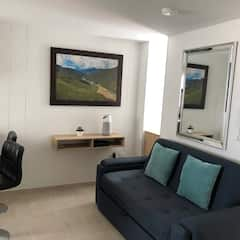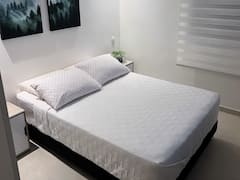Working for something makes the reward all the sweeter. I have always believed this to be true, but I think it applies especially when hiking and travelling.
One of the must-sees in the Santander region of Colombia, is the Chicamocha Canyon. You have two options for viewing this natural wonder: Take a day trip to the lookout on the highway, or work hard for your oh-so-sweet rewards, and hike there. The journey from Cabrera to Los Santos via the canyon involves three days of wandering through the back country of Colombia. The climb up the hill through the jungle will take you to Barichara, a charming and quaint colonial village.
The loooong, dry hike through farmland and villages that make you feel like you’ve gone back in time 100 years will lead you to the edge of the canyon where you will gasp at the grandeur before you, and the stumble down the canyon-side with sore knees and a parched mouth will take you to an honest-to-goodness ghost town; crumbling swing bridge and all.
General tips for the hike

The Chicamocha Canyon presents a challenging walk with many steep sections to climb or descend, so a certain level of fitness is required. It’s also not a particularly well marked track, so being able to ask for directions in Spanish is useful, although not impossible - saying the name of your next destination and following pointed fingers should help you along the way but the problem with this approach is that in Colombia, time and direction seem to work differently to the rest of the world. You can ask three different people how far you have to go, and you’ll get three different answers ranging from two minutes to two hours. The same applies to direction.
The way to avoid this, is to stay at Macondo hostel in San Gil. Shaun (the owner) has a wealth of knowledge about San Gil and the surrounding area. There’s a book in the communal area of the hostel with instructions for the 3-day Chicamocha canyon hike (too long to reproduce here - this is just a basic outline of the sorts of things you can expect, and some tips from someone who’s ‘been there, done that’). Take photos of those instructions, take them with you, and do not lose them.
Day One, Cabrera - Barichara - Guane

Begin your first day early, as you’ll need to catch a four hour bus from San Gil to Cabrera, the starting point for the trail. Warning: depending on how sociable your driver is, the four hours may turn into six. Account for this, and catch the earliest bus you can. The trail starts with a very steep climb up a jungled hill. The summer heat in May could be oppressing, making the climb even harder. Unfortunately, this will be the case no matter when you walk the trail. November, December and January are apparently very slightly cooler, but still see temperatures around 25 degrees Celsius. Despite the heat, looking out over the expansive hillsides dotted with villages is exhilarating and well worth the work (there are those sweet, sweet rewards already). The first section of the hike mostly takes you through this lush jungle, until you reach Barichara. The village in one word: Quaint. Cobblestone streets, pristine white walls, terracotta tile roofs, and children and dogs frolicking in the tree-lined plaza make it a much more peaceful place to base yourself than nearby San Gil, where most travellers stay.
If you’re doing this hike, however, you’ll just be passing through (the timing is perfect for a lunch stop). The 9 km section of trail between Barichara and Guane is called the Camino Real. It’s part of an ancient network of trails originally built by the Guane indigenous people, then used by the Spanish, and was apparently restored by a German man in the 1800’s.
The scenery in this section is completely different to the previous one. The cracked, intermittently cobbled footpath lined with vine-draped crumbling rock walls and aromatic shrubs make you feel as if you’re in the Mediterranean.
Stay in Guane on the first night of your trail

Guane is recommended by most as the place to spend your first night on the trail. There are a couple of lovely little inns (called ‘posadas’ in Spanish) in the village. As this area is very isolated, fresh vegetables are scarce and the shop charges a lot for basics like bottled water. Carrying a little more food with you from San Gil will make your life a LOT easier!
The locals are extremely friendly. There is a gaggle of elderly men in straw hats who spend their evenings smoking and watching the goings on in the square. If you’re open and friendly, they’ll happily chat to you - whether you speak their language or not! The youngsters of the village will be happy to let you join their game of soccer; they’re always looking for new people to beat. This is why I always prefer to take the long way; all these joyful little experiences truly make it the journey that matters, not the destination…and the cliché lives on.
You might be interested in these Airbnbs!
Day two - Guane to Jordan

The next day will take you through farmland and small villages until you get to the canyon edge, which you then have to go over to clamber down until you reach Jordan at the bottom. It’s a long day of hiking with no shade, and shops are few and far between, so leave Guane early with your cap and sunglasses at the ready, and stock up on water before you go.
The first half of the day is noteworthy because of the simplicity of life you’ll observe. Scenes like those you might expect from centuries ago - women milking a single cow with a pail and three legged stool, men herding goats, and children skipping along the dirt track on their way home from school at midday. There are also a LOT of dogs, which don’t necessarily fit with the rustic scenes I’ve painted for you - but regardless, beware of the dogs. They are not well trained, and they are not cuddly family pets.
The highlight of day two is the stumble-and-clamber descent of the canyon. It’s steep and killer on the knees but the views are breathtaking and arriving at the village at the bottom (Jordan - pronounced ‘Hordaan’, as I eventually learned) is an experience in itself.
Accommodation in Jordan

Jordan is essentially a ghost town. Most of the buildings are crumbling and boarded up, windows are entwined with vines and roads mostly deserted. As there might be no one to ask about accommodation options, I would recommend you to check where accommodation is available shortly before leaving. There used to be 800 people living in the canyon. Now there are 8 families, so around 50 people. The dramatic drop in population was due to the road through the canyon being replaced with a better, more direct road around the top which diverted all trade and traffic away from Jordan. Yet another example of how walking this trail is essentially an experiment in time travel.
Day 3: The Ascent - Jordan to Los Santos

Here are some pro-tips for the dreaded 6 hour ascent of the Canyon-side to Los Santos. Pro-tip number one: Leave at 4am. That way, you’ll avoid the heat and get to see the sun rise over the canyon, and have time for ice cream at the top before your bus arrives. Pro-tip number two: DO have a torch ready for the early morning (in the dark) crossing of the ancient, very creepy and creaky swing bridge, because you don’t want to put your foot through one of the holes, in the dark, in a ghost town. Pro-tip number three - have a headband or shirt that you can use to wipe your brow. You will sweat, and sweat mixed with sunscreen in the eyes is no fun at all. The last day is the most straightforward, as there’s only one path up the canyonside. There is some traffic on the path, so in case you did somehow manage to get lost, there are people to ask.
Once in Los Santos, there are two buses leaving from the main square which will take you back to San Gil (make sure you ask the driver about the route, as you may be required to change buses).
Jungle fun
Three days. Jungle, colonial villages, paved shady footpaths, dusty farmland, canyon views, ghost towns. Why would you skip all this and pay just as much for one bus trip to look out over the canyon from above? Take the long way, and enjoy the experience!
History
Get Trip101 in your inbox
Unsubscribe in one click. See our Privacy Policy for more information on how we use your data




















Create an account to